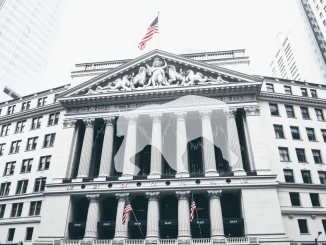
The world of finance is constantly evolving, and one trend capturing significant attention is the increasing adoption of cryptocurrencies by traditional businesses. Forget the individual investor; we’re now seeing public companies crypto assets in their strategic reserves. This corporate crypto hoarding trend is more than just news; it’s a signal that could challenge prevailing concerns about a potential crypto bubble bursting.
What Does Corporate Crypto Hoarding Mean for Market Risk?
A recent report highlighted by The Block, citing insights from Presto Head of Research Peter Chung, points to this surge in companies adding crypto to their balance sheets. This development offers a counterpoint to worries often discussed in market circles. Concerns about a crypto market risk event, potentially triggered by leveraged positions of crypto fund managers in a bear market, are valid. Such a scenario could indeed lead to forced liquidations, reminiscent of past downturns.
However, Chung’s analysis suggests this specific risk, while present, might be more manageable compared to the systemic collapses witnessed in prior cycles, such as the implosions of the Terra ecosystem or Three Arrows Capital (3AC). These past events involved complex, often opaque, and highly leveraged structures that had cascading effects across the market.
Comparing Current Risks to Past Crypto Cycles
The key difference identified in the Presto Research findings lies in how these public companies are utilizing their crypto holdings. The report notes that a significant number of firms—currently 228 companies globally—have strategically adopted crypto hoarding by adjusting their corporate structures specifically for acquiring digital assets.
Unlike some entities in the 2021 market peak who used their crypto as collateral for large loans, these corporate hoards are rarely leveraged. This distinction is crucial. When assets are not used as collateral, the risk of forced selling due to margin calls or loan defaults is drastically reduced. This inherently lowers the potential for systemic liquidation cascades that amplified volatility in previous market crashes.
Who’s Participating in Corporate Crypto Hoarding?
The list of companies engaging in corporate crypto hoarding includes diverse names across various sectors. Firms like Metaplanet, GameStop, and Trump Media are examples of publicly traded entities that have made strategic moves to incorporate crypto assets into their corporate treasuries. This isn’t just a tech industry phenomenon; it’s spreading.
Their approach often involves direct acquisition and holding, rather than complex financial engineering using the crypto as a borrowing base. This suggests a long-term strategic view on digital assets, possibly seeing them as a store of value, an inflation hedge, or part of a future digital economy strategy.
The Remaining Crypto Market Risk for Corporate Holders
Despite the reduced risk of leverage-induced liquidation, the Presto Research report acknowledges one potential vulnerability: the need for urgent cash. In the event of a severe liquidity crisis affecting a company’s primary business operations, they might be compelled to offload their crypto holdings to meet immediate financial obligations. While this is a possibility, it’s typically a decision driven by specific company circumstances rather than market-wide margin calls.
Presto Research and Peter Chung’s Perspective
The analysis from Peter Chung at Presto Research provides a nuanced view. It doesn’t dismiss market risks entirely but reframes the conversation around the *nature* of those risks. The growth of leveraged funds remains a factor, but the growing segment of unleveraged public companies crypto holders provides a different kind of market participant – one potentially less prone to panic selling during downturns compared to highly leveraged entities.
In Conclusion: A Shifting Landscape
The significant increase in corporate crypto hoarding by public companies is a compelling trend. It suggests that while crypto market risk factors persist, the composition of market participants is changing. The strategic, unleveraged accumulation by corporations, as highlighted by Presto Research and Peter Chung, offers a potential stabilizing force and indicates that concerns about an imminent, leverage-driven bubble burst might indeed be overblown relative to past cycles. This doesn’t eliminate volatility, but it points to a maturing market with different dynamics at play.



